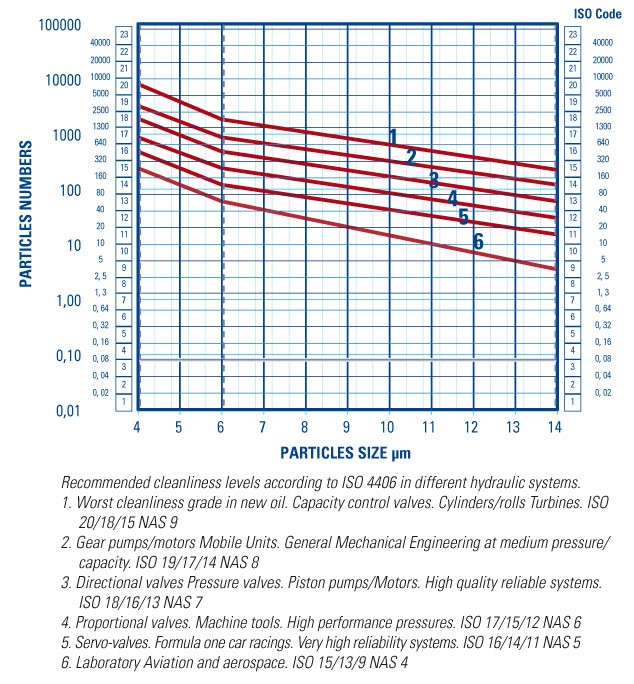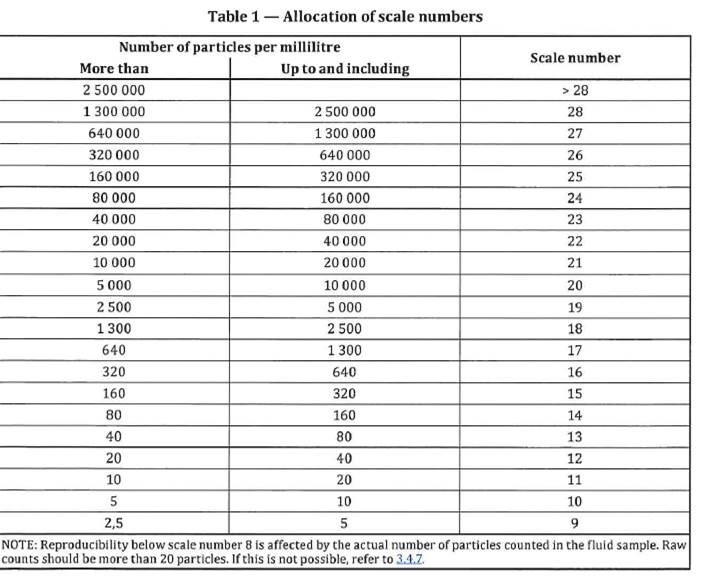NAS 1638 / ISO 4406
Encoding method of the level of contamination based on the number of particles per unit of volume divided into size classes. Standard NAS 1638 is still used, yet due to the fact that by now it is considered obsolete, it has been replaced by standard AS4059 / ISO 4406 that concerns the encoding of the level of contamination of a fluid. In a hydraulic system, the fluid re-circulates and tends to reach a stable level of contamination over time, that reflects the characteristics of the type of filter used. The sizes of the particles of interest will be those appropriate to the power of removal of the filter.
In standards NAS 1638 and AS4059E, the particles are grouped into intervals as per size: between 5 and 15 µm, between 15 and 25 µm, between 25 and 50 µm, between 50 and 100 µm and, finally, over 100 µm. A class identification is attributed to each of these ranges of values, based on a numerical comparison of the particles present with a standardised table.
The NAS class is identified with a single value. In this case, that however does not represent a sufficiently exhaustive picture of the status of the oil, the maximum value of the various sizes is taken into consideration.
Standards NAS 1638 and AS4059E
| Class | 5 ÷ 15 | 15 ÷ 25 | 25 ÷ 50 | 50 ÷ 100 | > 100 |
|---|---|---|---|---|---|
| 00 | 125 | 22 | 4 | 1 | 0 |
| 0 | 250 | 44 | 8 | 2 | 0 |
| 1 | 500 | 89 | 16 | 3 | 1 |
| 2 | 1.000 | 178 | 32 | 6 | 1 |
| 3 | 2.000 | 356 | 63 | 11 | 2 |
| 4 | 4.000 | 712 | 126 | 22 | 4 |
| 5 | 8.000 | 1.425 | 253 | 45 | 8 |
| 6 | 16.000 | 2.850 | 506 | 90 | 16 |
| 7 | 32.000 | 5.700 | 1.012 | 180 | 32 |
| 8 | 64.000 | 11.400 | 2.025 | 360 | 64 |
| 9 | 128.000 | 22.800 | 4.050 | 720 | 128 |
| 10 | 256.000 | 45.600 | 8.100 | 1.440 | 256 |
| 11 | 512.000 | 91.200 | 16.200 | 2.880 | 512 |
| 12 | 1.024.000 | 182.400 | 32.400 | 5.760 | 1.024 |
Standard NAS 1638 has been developed in order to define the levels of contamination in the aerospace sector. Standard NAS 1638 has been replaced by standard AS4059, the E version of which has been adapted so as to provide data on the levels of contamination for both cumulative and differential values.
| ISO 11171 Calibration | >4 µm (c) | >6 µm (c) | >14 µm (c) | >21 µm (c) | >38 µm (c) | >70 µm (c) | Corresponding to ISO class 6, 14 µm (c) |
|---|---|---|---|---|---|---|---|
| SAE CODE | A | B | C | D | E | F | |
| 3 | 6,250 | 2,430 | 432 | 76 | 13 | 2 | 12/9 |
| 4 | 12,500 | 4,860 | 864 | 152 | 26 | 4 | 13/10 |
| 5 | 25,000 | 9,730 | 1,730 | 306 | 53 | 8 | 14/11 |
| 6 | 50,000 | 19,500 | 3,460 | 612 | 106 | 16 | 15/12 |
| 7 | 100,000 | 38,900 | 6,920 | 1,220 | 212 | 32 | 16/13 |
| 8 | 200,000 | 77,900 | 13,900 | 2,450 | 424 | 64 | 17/14 |
| 9 | 400,000 | 156,000 | 27,700 | 4,900 | 848 | 128 | 18/15 |
| 10 | 800,000 | 311,000 | 55,400 | 9,800 | 1,700 | 256 | 19/16 |
| 11 | 1,600,000 | 623,000 | 111,000 | 19,600 | 3,390 | 512 | 20/17 |
| 12 | 3,200,000 | 1,250,000 | 222,000 | 39,200 | 6,780 | 1,020 | 21/18 |
Cleanliness classes according to SAE AS4059 and conversion to corresponding cleanliness classes according to NAS 1638 and ISO 4406.
Alternatively, standard ISO 4406 uses automatic particle counters that consist of three different scale levels that identify the differentiation of size and distribution of particles. The code is expressed in three values, that identify in the following order:
-
The number of the first scale represents the number of particles equal to or exceeding 4 µm per millilitre of fluid
-
The number of the second scale represents the number of particles equal to or exceeding 6 µm per millilitre of fluid
-
The number of the third scale represents the number of articles equal to or exceeding 14 µm per millilitre of fluid
- ISO CODE 18: Particles > 4 micron
- ISO CODE 16: Particles > 6 micron
- ISO CODE 13: Particles > 14 micron
Classification class with the corresponding particle numbers for the definition of the cleanliness classes according to ISO 4406.
| ISO 4406 class | Micron | Particles counted in the class (per ml) |
|---|---|---|
| 18 | >4 | 1.300 ÷ 2.500 |
| 16 | >6 | 320 ÷ 640 |
| 13 | >14 | 40 ÷ 80 |
In the ISO class there are 30 different codes. Each code quantitatively identifies a minimum and a maximum of particles, of sizes exceeding those of reference, present in the fluid indicated (1 ml). The readout mode is shown below:
| Number of particles per 1 ml | Code numbers | |
|---|---|---|
| exceeding | up to | |
| 2,500,000 | - | >28 |
| 1,300,000 | 2,500,000 | 28 |
| 640,000 | 1,300,000 | 27 |
| 320,000 | 640,000 | 26 |
| 160,000 | 320,000 | 25 |
| 80,000 | 160,000 | 24 |
| 40,000 | 80,000 | 23 |
| 20,000 | 40,000 | 22 |
| 10,000 | 20,000 | 21 |
| 5,000 | 10,000 | 20 |
| 2,500 | 5,000 | 19 |
| 1,300 | 2,500 | 18 |
| 640 | 1,300 | 17 |
| 320 | 640 | 16 |
| 160 | 320 | 15 |
| 80 | 160 | 14 |
| 40 | 80 | 13 |
| 20 | 40 | 12 |
| 10 | 20 | 11 |
| 5 | 10 | 10 |
| 2.5 | 5 | 9 |
| 1.3 | 2.5 | 8 |
| 0.64 | 1.3 | 7 |
| 0.32 | 0.64 | 6 |
| 0.16 | 0.32 | 5 |
| 0.08 | 0.16 | 4 |
| 0.04 | 0.08 | 3 |
| 0.02 | 0.04 | 2 |
| 0.01 | 0.02 | 1 |
| 0.00 | 0.01 | 0 |
Extract from standard ISO 4406

Assignment of the scale numbers in relation to the number of particles present:



To download the standards:
